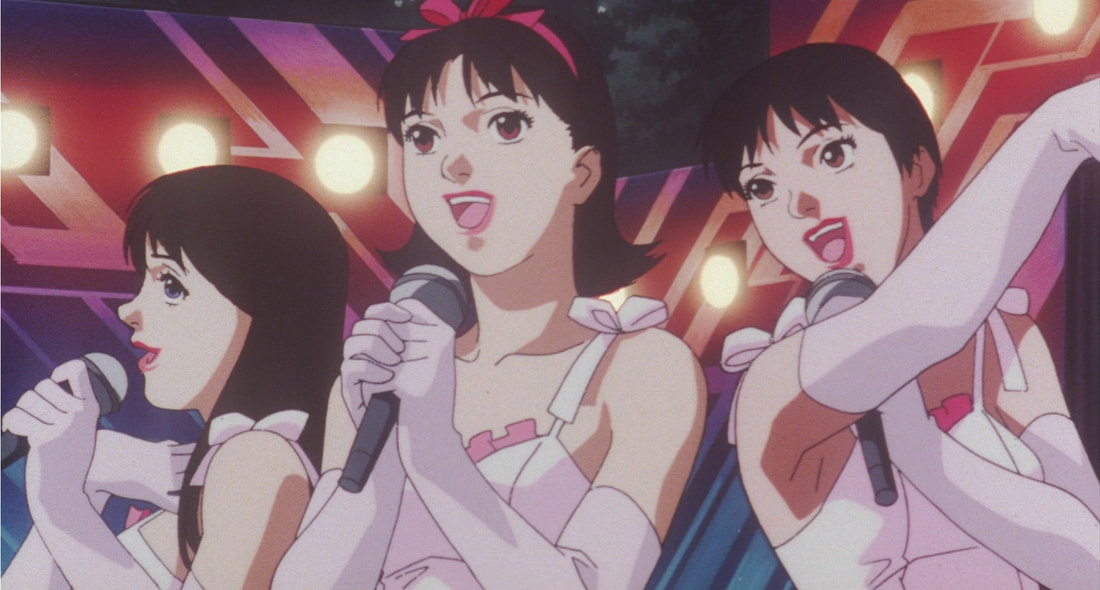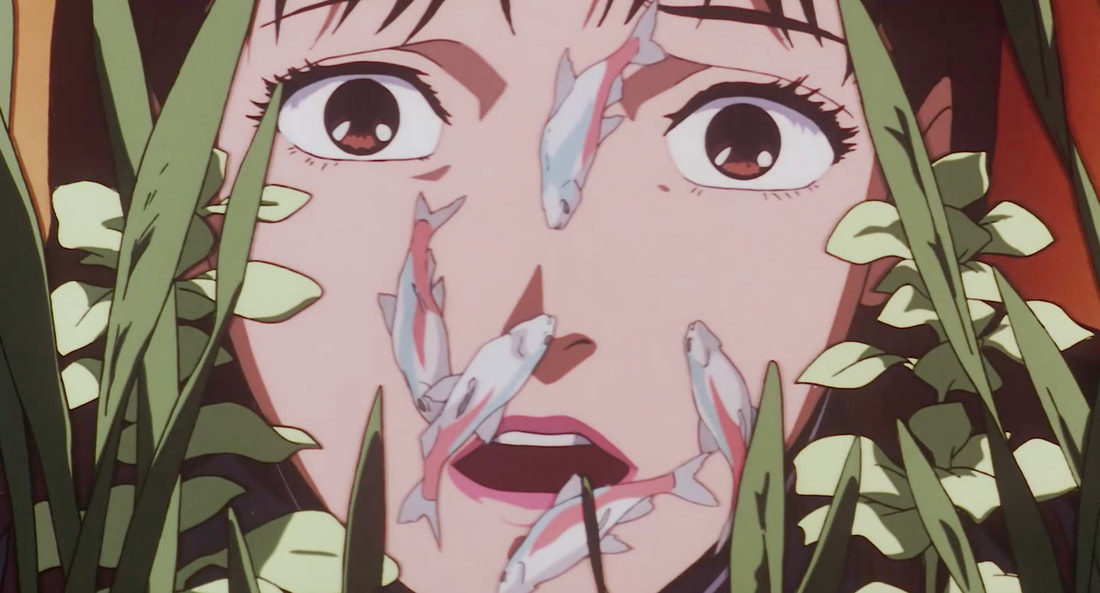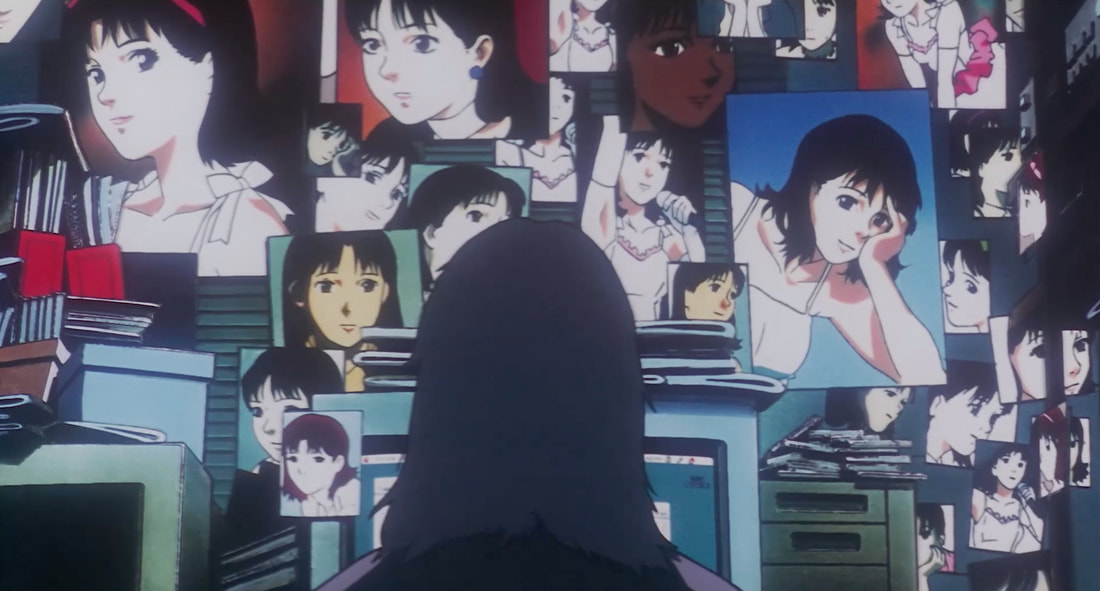|
As somebody with a major interest in Idol Activity, as well as Psychology, Perfect Blue was probably one of the best anime movies that I could have experienced in 2018. When I saw it was in theaters for its limited anniversary release, I was happy to grab tickets and use that as an excuse to stop doing things on my phone for literally any length of time. I went into Perfect Blue with no synopsis, spoilers, or expectations other than knowing that it was Satoshi Kon’s work AND, from what people told me, it's a TRIP. That being said, if you are interested and have never seen the film, go give it a watch before you read this review - it will be spoiler heavy. (In fact, the entire overview is actually a loose play-by-play of the film!!!! YOU HAVE BEEN WARNED!) If you don’t mind spoilers or have already seen it, keep on reading! Side Note: In my opinion, watching anime movie releases is one of the best ways we can support the industry and show interest in anime in our local communities. From ghibli festivals to new shounen title movies to 20th anniversary reruns - I really strongly believe in the support and impact each individual makes in bringing this content overseas! Please do your best to legally support the industry you love and cherish! Now, to get off my soapbox, please enjoy the Perfect Blue review! WARNING: Perfect Blue, and thus this review, talk about themes of rape and mental illness. { INFORMATION & OVERVIEW }Satoshi Kon was known as an amazing mangaka, animator, screenwriter, and film director within the industry, capitalizing on psychological themes and horror that may, or may not, have hit too close to home. His inspiration was said to explore the social stigmas and psychological side of humans in a way that makes his viewers feel introspective. Not only did Satoshi Kon bring us Perfect Blue, but he was also well-known for Paprika, Tokyo Godfathers, Millenium Actress, as well as numerous other works such as Jojo’s Bizarre Adventure, World Apartment Horrors, and Patlabor 2. His works even went on to inspire Director Darren Aronofsky in parts of his films: Requiem for a Dream and Black Swan. Perfect Blue is a story about a young aspiring Idol and actress, named Mima Kirigoe who leaves the idol industry for a better career in acting. Fans are outraged by her leaving her group, “CHAM!” and stop supporting Mima in her dreams. One person, however, is supporting Mima… Her stalker, who is called “Me-Mania”, begins to stalk her even more viciously after she leaves the group. With fear of both this stalker and her upset fans, Mima eventually gets her very own desktop computer and finds a website called “Mima’s Room”. This website is devoted to very in-depth posts about Mima’s daily activities, and though she is afraid, she is told by her management not to worry about it. Throughout the start of her acting career, things are clear and she feels confident… but as time goes on, and after a particularly dramatic rape scene in the show she is working on, the divide between reality and show business begins to blur for Mima. There are bombs sent to people working on the show and after the writer is found dead, Mima begins to question her own innocence. As time goes on, the blur between what is work and what is reality sets in even for the movie’s viewers themselves, as we see a scene of Mima’s character in a psychiatrist office being diagnosed with Dissociative Identity Disorder.,. “Cut!” is called and thus ends her time working on the show. This scene really has the entire movie descend into madness as Rumi is discovered to have been suffering a Folie à deux throughout the movie and attempts to kill Mima. The movie ends by showing Mima, a now accomplished actress, visiting Rumi who still believes she is the Idol Mima… { CINEMATOGRAPHY }Perfect Blue is a movie from ‘97, and with that being said, the artistry that went into the film, not only in animation and screenplay, but also conceptually, is astounding. There is use of the bold color red to signify and intensify scenes - see the red dress that Idol Mima wears especially! The major theme of the film revolves around the mental health of those in the entertainment industry and the cinematography of the film really helps encourage viewer to get lost with Mima. This is done through not only keeping scene transitions open for interpretation, but through the high angles often used to illustrate Mima’s own out of body disassociation, particularly during the infamous rape scene. The higher the angle of the scene gets, the less Mima in touch with true herself, and it becomes more and more apparent. Another way the film helps the viewer feel out of control is through the fast scene transitions as the movie reaches its climax. The use of reflection in Perfect Blue is another thing that is often used in movies and media to allude to conflict, and the inner turmoil in each reflection is very clear. In the cinematography sense, Perfect Blue is a fantastically thoughtful movie and really gives the viewers a feel of the insane tale that happens to Mima. I daresay that it is one of the best fiction movies in relation to the issues of DID that are out there. { IDOL VIEWPOINT }When it comes to idols in the 90’s, (cue ‘running in the 90’s’), there was a very different type of idol atmosphere than today. The entertainment industry for idols was - and can still be - very strict and full of guidelines and rules about their personal lives. Not to say that being an idol is not worth it, because for many people it is, however when you look at the movie Perfect Blue you are able to see what the entertainment industry could really be like. First of all, “SHAM!”/”CHAM!” the idol group with Mima was growing slowly more successful. There were many fans of the group and when the management decided to have Mima go more into acting, she was internally struggling. Being an Idol was her dream, but she was giving it all up for still more success… While her agent, Rumi, was distraught and angry at the management of the company for the decision, Mima acted maturely and decided to give it a try. However, her leaving was a boom for the group and it’s very clear that Mima was struggling with both supporting her former groupmates and dealing with her own troubles, much on her own. It’s clear that they are successful and happy despite Mima having left and her struggle within her acting career only helps to further the divide. Personally, I cannot imagine such a big change not being painful in some ways. It’s difficult for anybody to chase their dream, but I think it is more difficult to realize they let go of their dream and have to see it happen from another perspective. Stalking is another thing that many people have had to deal with throughout their careers in the entertainment industry. Mima is no exception as she deals with a particularly violent stalker throughout the film from her final live with CHAM! to the end of the movie. There is definitely a point at which the stalking gets to her and it exacerbates the already growing dissociation from reality from which Mima suffers. Her stalker ends up being not just one person, the suspect of the film, but also her manager Rumi who impersonates her in her own way. Stalking is of course a very serious offense however Rumi tries to brush the issues that Mima brings up off - as if it is all part of being in the industry. While people have to struggle with stalkers and violent and opinionated admirers, the extents that it goes to in Perfect Blue really shows the power of how easy stalking will be with the rise of the internet. This prediction of the boom of the internet, and the ease of access to false information, is a definite jab by Satoshi Kon to the changing times when the movie was released. Not only does it give people an easy way to see public figures in entertainment, but it also gives a whole new form of media to the industry as a whole. This declaration of the positives and negatives of the internet and the industry really are a good place to start thinking about the image behind Satoshi Kon’s films and what he really wanted viewers to get from his works. { PSYCHOLOGICAL VIEWPOINT }Perfect Blue is astoundingly forward for its headfirst dive into one of the more complex psychological issues; Dissociative Identity Disorder and (the unlisted in the DSM) “Shared Psychotic Disorder”. In order to fully talk about these with good understanding, I think it is important to define these. Dissociative Identity Disorder is defined by the DSM as: a mental disorder characterized by two (or more) distinct personality states, thus having two (or more) distinct personalities. Often times, periods of memory loss, loss of self, and depending on the severity, loss of personal function in everyday life. “Alters”, the term for the various personalities, are often given a “main” or most common personality, and the others are all Alters brought on by the disorder. This is also has a high comorbidity with Post-Traumatic Stress Disorder, personality disorders, and other severe mental disorders. DID is very difficult to diagnose and often shows itself in very unique ways, as most mental disorders do. Being that it is difficult to diagnose, there are very few trustworthy reported statistics, but it is commonly estimated that DID affects 1% of the population. “Shared Psychotic Disorder” is a disorder that was cut from the DSM-5, however it is defined as a delusional belief, (and sometime hallucinations), that are transmitted from one person to another. This is often an otherwise healthy individual sharing the thoughts of a disordered person. Both people often have very close ties to one another, therefore the ability to share this belief so easily. However, due to it not being in the DSM-5, it is not a mental disorder that can be officially diagnosed and statistics for this are untrustworthy. In the film, Mima’s character in her TV Show ends up being diagnosed with Dissociative Identity Disorder in the last episode in order to explain the murder that happens during the show. This is likely brought on by the character having been raped and losing her family members as a child, however that fact remains unclear to the viewer. In the reality of the movie, however, it turns out that the Idol Mima is an alter of her manager, Rumi, and she results to violent hallucinations and delusions against the real Mima. Her delusions go as far as controlling Mima’s stalker, who at the beginning of the film had harbored no ill actions against Mima herself. This ties hand in hand with the Shared Psychosis between Rumi and Mima. Mima was, for the most part, a mentally stable young woman pursuing her career, however with Rumi being the only person to stand up for her and protect her, there was a bond established between the pair that could not be replaced by any other person. Especially considering that Mima moved into the city in order to start her career, so she often lived on her own and spent her nights relatively lonely. Between that and leaving her idol group, Rumi was one of the only people that Mima spent time with throughout the film. As earlier stated, that special bond was enough to possibly have transmitted the hallucinations and beliefs between Rumi and Mima. Overall, with this Satoshi Kon really did his research on these disorders that are highly misunderstood by society. His spotlight on such rare disorders and overcoming the normal stigma and assumptions really give this film a shine to those interested in psychology. The only thing I could use would be the background of Rumi, a whole film about her could really spell things out - however that is not what Satoshi Kon intended. In his interview which played after the screening, he talked about how he liked to leave certain things open, and I think that this is certainly one of those things that he believes we can figure out for ourselves. { OVERALL }I can say that Satoshi Kon’s Perfect Blue is very much a masterpiece in its own rights. The animation and thoughtfulness put into the film in every aspect is not to make money- it’s to send a message. Whichever message you analyze out of the film, I think is the message that is intended! When watching it, I kind of had trouble processing what exactly was going on. I got INCREDIBLY excited and confused during the “psychological diagnosis” scene, only to realize it was part of the show. And then I thought: “What possibly is next!?”. The quick scene changes, the mesmerizing 90’s era animation, the music and use of voice acting… Everything really sucked me into the film making me come out feeling like I had seen something that was… very different than the normal movie. The amount of thought that went into the psychological aspects of this film astounds me due to the fact that mental health is not even a large topic in most countries even in 2018. This movie, amazingly, goes into the nitty gritty foundations of a disorder so complex that it is often shown wrong in the majority of media. It even touched on a disorder that I had never studied or heard of in my time in college. Without continuing to dissect this film, I’m going to give it my short stats - because I could go on and on about it. -Sara (Swittx) Cinematography: 10/10 Writing: 10/10 Acting: 10/10 Recommended: Highly for Mature Audiences Warning: TW for Stalking and Rape, much violence too. Overall Rating: 10/10 Psycho Mima
0 Comments
Leave a Reply. |
Search
Contributors◆ Hinacchi
◆ J.D. ◆ Janette ◆ Manuel ◆ Megan ◆ Nestor ◆ Rose ◆ Sylvia ◆ Teepu Support Us On Patreon!
Archives
June 2025
|
© 2014-2025 A-to-J Connections. All Rights Reserved.









 RSS Feed
RSS Feed